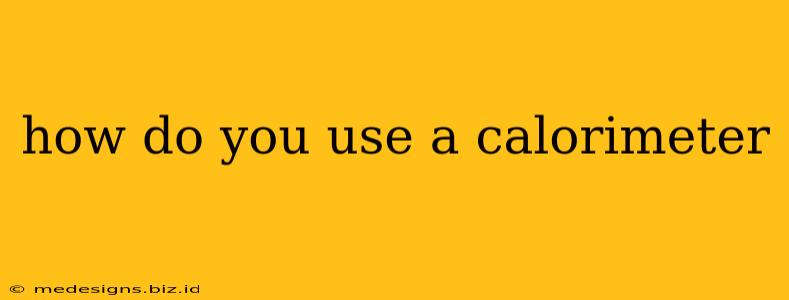Calorimeters are essential tools for measuring the heat flow of chemical or physical processes. Understanding how to use one accurately is crucial for various scientific applications, from determining the specific heat capacity of materials to analyzing the energy content of foods. This guide provides a step-by-step process for using a calorimeter, focusing on the common types and essential safety precautions.
Types of Calorimeters and Their Uses
Before diving into the process, it's important to understand that there are different types of calorimeters, each designed for specific applications:
1. Constant-Volume Calorimeter (Bomb Calorimeter):
This type is primarily used for measuring the heat of combustion of substances. It's a sealed, high-pressure container where a sample is ignited, and the resulting temperature change is carefully monitored. Bomb calorimeters are ideal for determining the energy content of fuels and foods.
2. Constant-Pressure Calorimeter:
This calorimeter operates at constant atmospheric pressure. It's frequently used in studying reactions in solution, where the heat released or absorbed is measured directly. Coffee-cup calorimeters are a simple example of this type.
3. Differential Scanning Calorimeter (DSC):
A more sophisticated instrument, the DSC measures the heat flow associated with phase transitions (like melting or crystallization) and chemical reactions as a function of temperature. This is extensively used in material science and polymer analysis.
Step-by-Step Guide to Using a Calorimeter (General Procedure)
The specific procedures will vary depending on the calorimeter type, but some general steps are common:
1. Calibration:
- Crucial Step: Before any measurements, the calorimeter must be calibrated to determine its heat capacity (or calorimeter constant). This involves a known reaction with a precisely known heat change.
- Calibration Run: A known amount of a substance with a known heat of reaction (e.g., benzoic acid for combustion calorimetry) is reacted within the calorimeter.
- Calculation: The calorimeter constant is calculated using the observed temperature change and the known heat of reaction.
2. Sample Preparation:
- Accuracy Matters: Precisely weigh your sample using an analytical balance. The accuracy of your measurements directly depends on the precision of your sample mass.
- Proper Handling: Handle samples carefully to avoid contamination or loss.
- Specific Preparation: The sample preparation varies based on the type of calorimeter and the nature of the experiment (e.g., dissolving a solid in a liquid, igniting a solid in a bomb calorimeter).
3. Running the Experiment:
- Setup: Carefully place the prepared sample in the calorimeter. Ensure proper seals and connections (especially for bomb calorimeters).
- Initiate Reaction: Initiate the reaction (e.g., igniting the sample, adding a reactant).
- Monitor Temperature: Continuously monitor the temperature change using a high-precision thermometer or temperature sensor. Record the data at regular intervals.
4. Data Analysis:
- Temperature Change: Determine the maximum temperature change (ΔT) from the recorded data.
- Heat Transfer: Calculate the heat transferred (q) using the formula: q = Ccal × ΔT, where Ccal is the calorimeter constant.
- Moles of Reactant: Determine the number of moles of the reactant involved in the reaction.
- Enthalpy Change: Calculate the enthalpy change (ΔH) of the reaction using the formula: ΔH = q/n, where n is the number of moles of the reactant.
5. Safety Precautions:
- Protective Gear: Always wear appropriate safety glasses, gloves, and a lab coat.
- Proper Ventilation: Ensure adequate ventilation, especially when working with flammable or potentially hazardous substances.
- High-Pressure Systems: Handle high-pressure systems (like bomb calorimeters) with extreme caution and proper training.
- Disposal: Dispose of chemical wastes according to appropriate safety regulations.
Conclusion
Using a calorimeter accurately requires careful preparation, precise measurements, and a thorough understanding of the equipment and the underlying principles. By following these steps and prioritizing safety, you can effectively utilize a calorimeter to determine the heat flow associated with various chemical and physical processes. Remember to consult the manufacturer’s instructions specific to your calorimeter model for detailed operating procedures.
